Echos of futures past: A 24-hour bikepacking Rawland Ravn shakedown.
Originally posted on August 28, 2018 at 0:01 amWords and photos by Erik Mathy
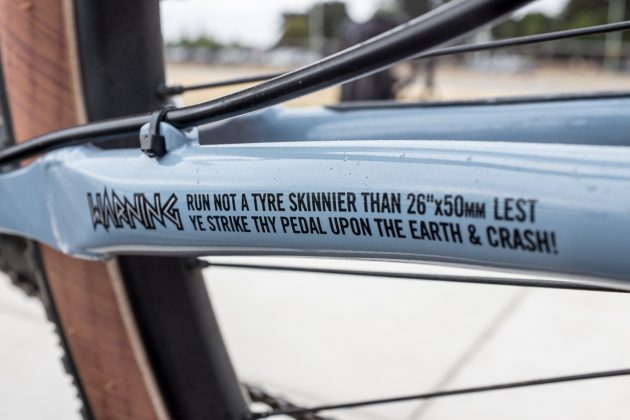 It was Sunday morning and I was running late, as usual. We’d had a last minute change in plans and family had stayed at our place overnight, nixing my ability to figure out what bags would fit where on the new Rawland Ravn. My original plan had been to pre-ride the first day of the Butterfield Overland Mail Route (BOMR) down to Gilroy and back. That was a solid, albeit flat, 80ish miles. Now it was close to 11:00 am, the bags I thought would carry my camera gear weren’t working, and I was starting again from scratch.
It was Sunday morning and I was running late, as usual. We’d had a last minute change in plans and family had stayed at our place overnight, nixing my ability to figure out what bags would fit where on the new Rawland Ravn. My original plan had been to pre-ride the first day of the Butterfield Overland Mail Route (BOMR) down to Gilroy and back. That was a solid, albeit flat, 80ish miles. Now it was close to 11:00 am, the bags I thought would carry my camera gear weren’t working, and I was starting again from scratch.
One of the things nobody tells you when you start the whole bikepacking thing is this: You’d better be good at puzzles. Putting together a bikepacking setup is just like assembling a puzzle. There’s the gear you have to bring: water bottles, tools, stove, first aid kit, shelter (tent/bivy/tarp/whatever), sleeping kit (pad/sleeping bag/quilt/whathaveyou), clothes, etc. There’s the kit you want to bring: camera equipment, in my case. Usually big, cumbersome, sometimes heavy, large format film camera equipment. Plus a tripod, film holders, spare film, lenses, light meter and a backup digital camera.
Trying to cram all of that onto a bike is hard. Trying to cram all of that with a hodgepodge of bags on a new bike with no time is harder. And so: I was running late.
As a result the BOMR Day 1 pre-ride was out. There was no way I was going to be able to get going in time to cover that distance. I’d have to go to the good ‘ol standby, China Camp. I love that place. My brother from another mother, Andrew Law, introduced me to China Camp’s singletrack long ago. We used to ride 2-3 laps of the outside loop on our singlespeeds before grabbing bagels and heading home. But there is also over 30 really nice campgrounds that, on a Sunday night, are usually only half full. And since it was on the way home, I figured I’d finally take a ferry over to Angel Island as well. In 20+ years of living in the Bay Area, that was one place I had never been.
Now the other thing about China Camp and Angel Island is that they have a history. I love places with history. Back in the mid 1800’s Chinese migrants had taken up residence there, establishing over two dozen small camps. At the height of the anti-Chinese hysteria of the 1880’s over 500 Chinese immigrants lived there to avoid persecution and discrimination in the cities. In 1882 the Chinese Exclusion Act was passed to restrict entry of certain classes of Chinese immigrants. It was the first law ever passed which restricted immigration in the United States. Eventually, in 1910, the Immigration Station on Angel Island was built. For 32 years, in increasingly poor conditions, Chinese immigrants were held up to 2 years while being processed. In some cases, families were separated completely, including children from their parents.

Eventually, I managed to hodgepodge together something that could hopefully work well enough for a 24 hour overnight. My tripod was jammed into the front left fork leg water bottle cage (don’t ask). An ancient hip camera bag was strapped to the front of a second camera bag on the front flat rack with my sleeping pad and some clothes jammed underneath both in a dry bag. The combination made the front end VERY top heavy. I didn’t like the feel but it would have to do. Everything else was in pretty standard places. Food, stove, first aid kit, tools, other misc small bric-a-brac were all in the Revelate tangle bag. Headlamp and snacks in the Revelate Gas Tank. My Nemo Hornet 2P, Enlightened Equipment quilt, Patagonia jacket, space blanket/ground tarp were all in the Revelate seat bag. The Gas Tank and seat bag I’d had since 2010. Oh, and at the last minute I shoved a book, wrapped in a watch cap, underneath everything on the front rack. Just in case I got the hankering to read once I set up camp.
The two best ways to start any kind of cycling trip are ferry and Amtrak. Living on one of the few fully inhabited islands in the San Francisco Bay Area gives the luxury of being able to start almost every adventure with a ferry ride. It’s one of those things that’s really hard to get tired of. You feel like you’re going somewhere far away and exotic, even if it’s only a short 20 minute ride across the Bay.
In the end, though, San Francisco actually is a pretty exotic place. That’s an easy thing to overlook, living here. When you step off the boat at the old ferry building to the sounds of historic cable cars intermixed with cars, locals, tourists, fellow cyclists and skateboarders it becomes well nigh impossible to ignore that we live in a pretty amazing, special place. Stopping to take photos with a 50’s era Speed Graphic with a homemade lens fit right in. Some kids took notice of it. Their 30 minutes of questions took more time than I’d wanted to spend since I was already running late. But…there are far worse ways to spend one’s time then, hopefully, igniting an imagination or two. So why not?
The ride from San Francisco to China Camp is a pretty straightforward one. Golden Gate Bridge on the weekend is a mess. Some locals get pretty upset with the tourists on rental bikes but, so what? They’re on vacation, having a good time albeit it in a cold, foggy, windy way. If they slow down your Strava time over the bridge by a few minutes, it won’t kill you. Anyways, after the Golden Gate it’s a pretty mellow roll out along the Sausalito bike path, over your choice of three different hills, through the pedestrian/bike tunnel into San Rafael and then along the back side of China Camp State Park to the campsites at the back meadows. The Neighbor of the Beast is out there, but they keep to themselves so don’t worry about it too much.
A funny kind of thing happened when I got there, though, besides the greeting party of deer at the campground entrance. The camp host, with his fabulous little dogs and disco music, directed me up the hill to Hike/Bike Site 2. He said it was by far the best HB spot, tucked away up on the hill, and it hadn’t been taken. Yet, when I got there, a nice gentleman with a pretty stylish RB-2 had already claimed the spot. He was riding down to Monterey to see his daughter and had been told by the camp host to use it when he checked in at 3:00 pm. So, OK, fine, I went down, put his name on the board for HB-2 and went over to settle in at HB-1. At this point in time, it was getting dark. Lo and behold, when I got to HB-1, there was a pair of bikes, a tent, a very full picnic table, a fire in the fire pit and a very nice couple.
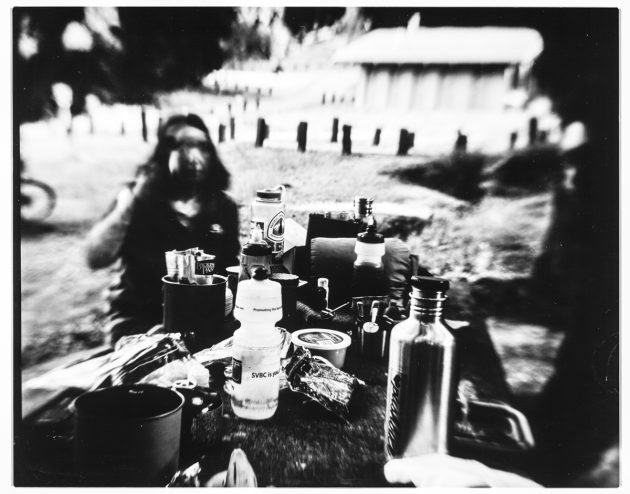
After chatting with them a bit (they’d checked in using the automated kiosk out front, not with the camp host) I turned to go sort it out with the camp host but something about the guy was bothering me. Not in a bad way. In a “Damnit, I know this guy.” way.
“Barry?”
“Erik?”
Sure enough, it was my buddy Barry. He was taking his partner Katrina out on her first bikepacking overnight from San Francisco. They were kind enough to invite me to share not just their campsite, but also their wine, whiskey, sausage log, cheese and most importantly, their company. It was an incredibly pleasant evening. We chatted, tried to spot shooting stars (there was a Perseid meteor shower that night), chased off raccoons and consumed snacks until late into the night.
The only thing that went awry was a raccoon raid at 12:40am. Someone (*cough* Barry *cough*) didn’t latch the food cabinet before they went to bed. He swears this is the first time that’s ever happened. Karma spoke, however, and the only thing that was lost before I shooed the little buggers away was Barry’s sandwich. Its sad remains awaited us the next morning. I didn’t know trash pandas would completely reject tomatoes, but the proud winner of last night’s lottery was apparently a fussy eater.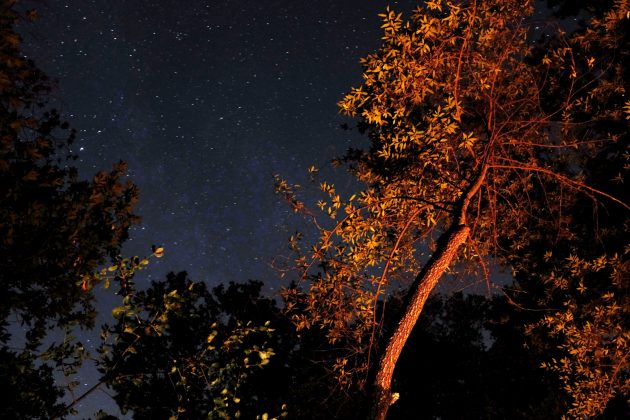
One of the challenges of shooting large format film cameras is that, when you’ve run through your loaded film, you can’t just reload the film holders in an instant. You need a lightproof room, preferably a clean one, to unload and reload the holders in. The second option is what’s called a changing bag. It’s a sealed bag that the film and holders are placed inside of with two sleeves for your arms. You stick your arms inside the sleeves and then unload/reload the film by feel. Changing bags aren’t very portable. I have a small one that’s just barely big enough to load sheet film in and a huge one that’s got plenty of room but is unwieldy. On my Route 66 trip, I carried 14 film holders to handle a week’s worth of shooting. They’re double sided so that’s 28 shots, or 4 per day. They were easily the heaviest thing in my entire kit.
I’d shot through my 4 holders the day before. While my water heated up for breakfast, I unloaded/reloaded film in preparation for Angel Island later in the day. And, of course, made a shot after breakfast. The sunrise at China Camp makes for lovely shadows among the trees at the campsite.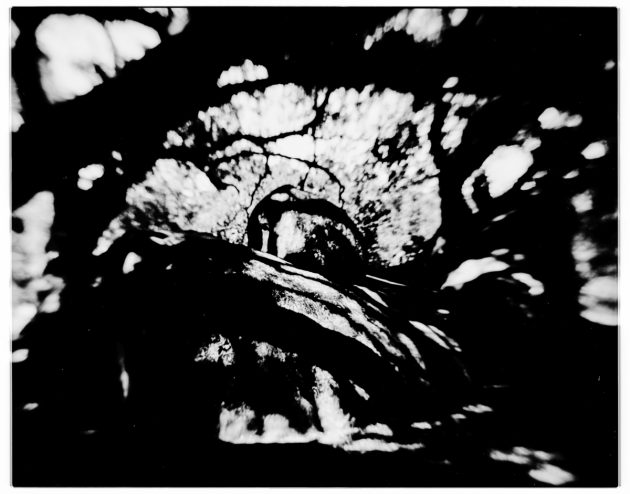
Tiburon, where the Angel Island ferry departs, is a nice little hour or so ride from China Camp. The cost for bikes is $10 but that includes the day use fee for the state park itself. The entire island is a California State Park. The staff lives there, even the seasonal employees, which makes it a highly sought after posting for the full-time California park employees. It’s a quiet and beautiful spot. Honestly, if I could live there, I would, too.
While Angel Island is gorgeous, it also holds a cautionary tale. From 1910 to 1940 the Angel Island Immigration Station was known as the “Ellis Island of the West”. While that may seem fine, the reality is that due to a rising wave of racial xenophobia, a series of increasingly race-based immigration laws were passed targeting Chinese immigrants. As a result, Angel Island became a place where Chinese immigrants were held, interrogated, and separated from their families for upwards to 2 years at a time. The facilities were overcrowded and unsanitary. Yet, even after all of that, those that made it through became citizens, started businesses, served in the US military in WWII and Korea, and contributed massively to America’s society and economy. Standing among those buildings, reading the testimonies of those who were held there and the blatantly racist words of some of the staff who worked there was sobering.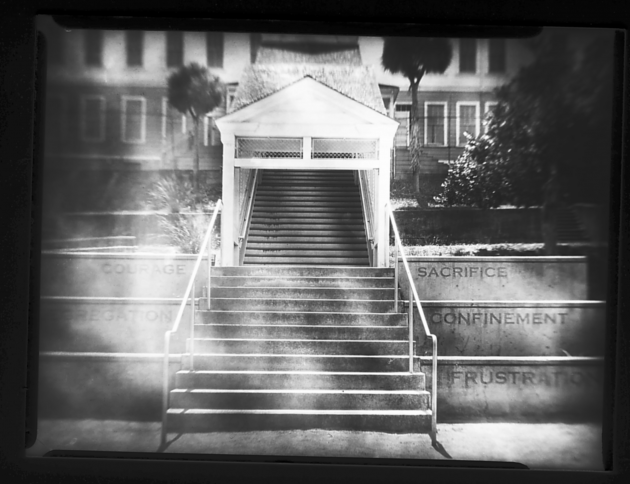
As I got on the last ferry off Angel Island back to San Francisco, I thought of an oft-paraphrased quote and wondered what was next. Not just for myself, but for all of us: “Those who cannot remember the past are condemned to repeat it.” – George Santayana